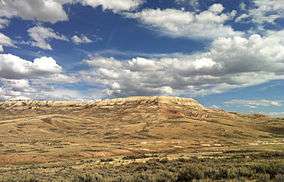Fossil Butte National Monument
| Fossil Butte National Monument | |
|---|---|
|
IUCN category V (protected landscape/seascape) | |
|
Fossil Butte National Monument | |
 Fossil Butte | |
| Location | Lincoln County, Wyoming, USA |
| Nearest city | Kemmerer, WY |
| Coordinates | 41°51′52″N 110°46′33″W / 41.86444°N 110.77583°WCoordinates: 41°51′52″N 110°46′33″W / 41.86444°N 110.77583°W |
| Area | 8,198 acres (3,318 ha)[1] |
| Established | October 23, 1972 |
| Visitors | 16,552 (in 2011)[2] |
| Governing body | National Park Service |
| Website | Fossil Butte National Monument |

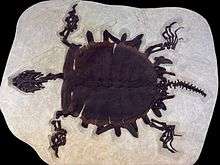
Fossil Butte National Monument is a United States National Monument managed by the National Park Service, located 15 miles (24 km) west of Kemmerer, Wyoming, USA. It centers on an extraordinary assemblage of Eocene Epoch (56 to 34 million years ago) animal and plant fossils associated with the smallest lake — Fossil Lake — of the three great lakes which were present at that time in what are now Wyoming, Utah, and Colorado. The other two were lakes were Lake Gosiute and Lake Uinta. Fossil Butte National Monument was established as a national monument on October 23, 1972.
Fossil Butte National Monument preserves the best paleontological record of Cenozoic aquatic communities in North America and possibly the world, within the 50-million-year-old Green River Formation — the ancient lake bed. Fossils preserved — including fish, alligators, bats, turtles, dog-sized horses, insects, and many other species of plants and animals — suggest that the region was a low, subtropical, freshwater basin when the sediments accumulated, over about a 2 million-year period.[3]
History
Coal mining for the railroad led to the settlement of the nearby town of Fossil, Wyoming.[4] When the fossils were discovered, miners dug them up to sell to collectors. In particular, Lee Craig sold fossils from 1897 to 1937. Commercial fossil collecting is not allowed within the National Monument, but numerous quarries on private land nearby continue to produce extraordinary fossil specimens, both for museums and for private collectors.
Exhibits
The Fossil Butte National Monument Visitor Center features over 80 fossils and fossil casts on exhibit, including fish, a crocodile, turtle, bats, birds, insects and plants. A 13-minute video is shown about the fossils found at the site and what scientists have learned. Interactive exhibits let visitors create fossil rubbings to take home, and a computer program discusses fossils, geology and the current natural history of the monument.
Activities
During the summer, lab personnel prepare fossils in public. Summer activities also include ranger programs, hikes, paleontology and geology talks, and participation in fossil quarry collections for the park.
_Fossil_Shack.jpg)
A Junior Ranger program can be completed by children aged 5–12 (with exercises scaled to the child's age) in 3–4 hours. A highlight is hiking 3/4 mile up the butte to the dig, where interns from the Geological Society of America talk about their excavation and let children help them flake apart sedimentary deposits to discover fish fossils and coprolites.
List of fossil species recovered at Fossil Butte National Monument
Fish:
- Asterotrygon, an extinct stingray
- Knightia spp, an extinct fish related to herring and sardines
- Diplomystus spp
- Heliobatis radians, an extinct stingray
- Notogoneus, an extinct bottom-feeding fish
- Crossopholis magnicaudatus (Commons), a 1-meter (40 inches) long predatory paddlefish
Mammals:
- Coryphodon spp
- Onychonycteris finneyi, a bat
- Heptodon spp, an extinct tapir
- Protorohippus sp., an early horse-like mammal
Birds:
Reptiles:
- Afairiguana, an extinct anole
- Bahndwivici, an extinct lizard
- Borealosuchus wilsoni, an extinct crocodile
- Baenidae turtle
Plants:
Primary source:[5]
Gallery
- Knightia eocaena fish, about 10 centimetres (3.9 in) long. Knightia is the most commonly excavated fossil fish in the world.[5]

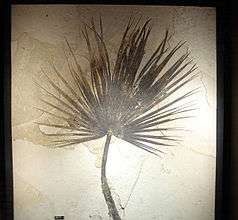
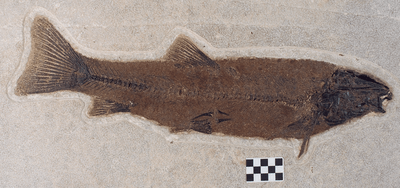
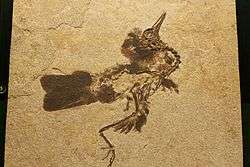 An unidentified fossil bird from FBNM, in the collections of the Field Museum
An unidentified fossil bird from FBNM, in the collections of the Field Museum A well-preserved Buprestidae beetle (3.5 cm/1.4 in long) from the FBNM collections. Other beetles, flies and Hemiptera bugs have also been found in the Fossil Lake sediments.[5]
A well-preserved Buprestidae beetle (3.5 cm/1.4 in long) from the FBNM collections. Other beetles, flies and Hemiptera bugs have also been found in the Fossil Lake sediments.[5]
See also
Other NPS Cenozoic Era sites in the western U.S.:
- John Day Fossil Beds National Monument, Oregon
- Hagerman Fossil Beds National Monument, Idaho
- Agate Fossil Beds National Monument, Nebraska
- Badlands National Park, South Dakota
- Florissant Fossil Beds National Monument, Colorado
References
- ↑ "Listing of acreage as of December 31, 2011". Land Resource Division, National Park Service. Retrieved 2012-05-14.
- ↑ "NPS Annual Recreation Visits Report". National Park Service. Retrieved 2012-05-14.
- ↑ Geologic travel guide from American Geological Institute
- ↑ "Fossil, Wyoming". rootsweb.ancestry.com. Retrieved 2008-05-06.
- 1 2 3 4 5 Green River Formation Fossils at Fossil Butte
External links
| Wikimedia Commons has media related to Fossil Butte National Monument. |
| Wikivoyage has a travel guide for Fossil Butte National Monument. |
- Photo tour of FBNM, from USGS
- Paleontology of Green River fossils, from University of California, Berkeley
- Geologic travel guide from American Geological Institute
